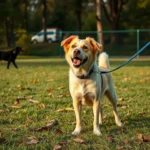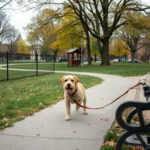
Cynophobia, or the fear of dogs, is a common yet often debilitating condition that affects many individuals. While statistics vary, studies suggest that approximately 10% of the population experiences a significant fear of dogs, which can stem from various sources. This fear can severely impact personal well-being and social interactions, making it essential to address and manage this phobia. In this article, we will delve into the nature of cynophobia, explore its causes and effects, and provide effective strategies to help you overcome a fear of dogs.
Understanding the Fear of Dogs
What is Cynophobia?
Cynophobia is defined as an intense fear or aversion to dogs. From a psychological perspective, it is categorized as a specific phobia, which is an irrational fear that leads individuals to avoid certain objects or situations. Symptoms of cynophobia can include sweating, increased heart rate, shaking, and even panic attacks when in the presence of dogs or when anticipating an encounter. It’s crucial to differentiate between a fear of dogs and cynophobia; while fear can be a normal response, a phobia is characterized by excessive and irrational anxiety.
Causes of Fear of Dogs
Several factors contribute to the development of cynophobia:
-
Childhood Experiences: Negative encounters with dogs during childhood, such as being bitten or aggressively approached, can leave lasting trauma. These experiences can instill a deep-seated fear that may persist into adulthood.
-
Cultural Influences: The portrayal of dogs in media can also impact perceptions. Movies and news stories that depict aggressive or dangerous dogs can reinforce fears and create misconceptions about dog behavior.
-
Psychological Factors: Individuals with underlying anxiety disorders or past trauma may be more susceptible to developing a fear of dogs. The mind may associate dogs with danger, even in benign situations.
The Impact of Cynophobia on Daily Life
Social Implications
Cynophobia can significantly affect social life. Individuals may avoid social situations that involve dogs, leading to missed opportunities for connection and camaraderie. This avoidance can strain relationships with friends or family members who are dog owners, resulting in feelings of isolation or embarrassment. Imagine being invited to a friend’s house only to decline due to their pet—this can lead to feelings of exclusion and sadness.
Practical Challenges
The practical implications of cynophobia are numerous. Individuals may find themselves limited in travel or outdoor activities, especially in areas known for dog owners, such as parks or beaches. Even attending gatherings at friends’ homes can become a source of anxiety if dogs are present. These limitations can hinder personal enjoyment and lead to a less fulfilling lifestyle.
Strategies to Overcome a Fear of Dogs
Education and Understanding
One of the first steps in overcoming a fear of dogs is education. Learning about dog behavior and body language can demystify these animals. Understanding that a wagging tail often signifies friendliness, while a growl indicates discomfort, can provide insights into how to interact with dogs safely. Additionally, familiarizing oneself with different dog breeds and their temperaments can help reduce fear by highlighting that not all dogs are aggressive.
Gradual Exposure Techniques
Gradual exposure is a proven method in exposure therapy, allowing individuals to confront their fears in a controlled manner. Here’s a step-by-step approach:
-
Start with Pictures and Videos: Begin by looking at images and videos of dogs. Familiarize yourself with their appearance and behavior in a safe environment.
-
Observe Dogs from a Distance: Progress to watching dogs in parks or neighborhoods from a safe distance. Note their interactions with people and other pets to build comfort.
-
Approach Friendly Dogs with Guidance: Once you feel more confident, ask a friend with a calm and friendly dog if you can observe and eventually interact. Start by standing at a distance, then gradually work towards petting the dog with guidance from its owner.
Building Positive Associations
Creating positive experiences with dogs can significantly help alleviate fear. Engaging in activities that promote positive interactions can include:
-
Visiting a Dog Shelter: Spending time with dogs in a shelter can help you understand their personalities and needs. Many shelters also offer programs where individuals can help train or socialize dogs.
-
Attending Dog Training Classes as an Observer: Observing professional dog training sessions can provide insight into how dogs learn and interact with humans. Watching trained dogs respond positively to commands can help foster a sense of safety and control.
Seeking Professional Help
If your fear of dogs significantly impacts your daily life, it may be time to seek professional help. Therapy options such as cognitive-behavioral therapy (CBT) and exposure therapy can be particularly effective in treating phobias. A qualified therapist can guide you through the process of addressing your fears and developing coping strategies.
Support groups for individuals with similar fears can also provide a sense of community and understanding. Sharing experiences and strategies can empower you to confront your cynophobia with the support of others.
Tips for Managing Anxiety Around Dogs
Breathing and Relaxation Techniques
When preparing to encounter a dog, it’s essential to manage anxiety effectively. Consider incorporating the following techniques:
-
Deep Breathing Exercises: Practice deep breathing to calm your nerves before approaching a dog. Inhale deeply through your nose, hold for a few seconds, and exhale slowly through your mouth.
-
Mindfulness and Meditation Practices: Engaging in mindfulness or meditation can help center your thoughts and reduce anxiety. Focusing on the present moment can diminish worries about potential dog encounters.
Preparing for Encounters with Dogs
Preparation is key to feeling secure in situations involving dogs. Here are some strategies:
-
Setting Personal Boundaries: Determine how close you feel comfortable being to a dog before entering a situation. Communicate these boundaries to the dog owner to ensure you feel safe.
-
Communicating with Dog Owners: Before encountering a dog, talk to the owner about your fears. A responsible owner will understand and make accommodations to ensure a positive experience.
Self-Compassion and Patience
Overcoming a fear of dogs is a process that requires time and patience. It’s important to practice self-compassion and recognize that progress may be gradual. Celebrate small victories along the way, whether it’s feeling more comfortable around a dog or successfully petting one. Each step forward is a step towards conquering your fear.
Real-Life Success Stories
Many individuals have successfully overcome their fear of dogs through perseverance and the right strategies. Here are a few narratives reflecting their journeys:
-
Sarah’s Journey: After being bitten as a child, Sarah lived in constant fear of dogs. By gradually exposing herself to friendly dogs and volunteering at a local shelter, she learned to appreciate their companionship. Today, she owns a rescue dog and shares her story to inspire others.
-
Mark’s Transformation: Mark struggled with cynophobia for years, feeling embarrassed at social gatherings. After counseling and engaging in exposure therapy, he learned to manage his anxiety. Mark now attends dog-friendly events and has even developed friendships with dog owners.
Expert Opinions
Insights from professionals in psychology and dog training emphasize the importance of understanding both the human and canine perspectives. Dog trainers often suggest that understanding a dog’s behavior can significantly reduce anxiety. Psychologists recommend addressing fears with structured therapy, highlighting that many individuals successfully manage and overcome their phobias.
Conclusion
Overcoming a fear of dogs is a journey that requires understanding, patience, and consistent effort. By educating yourself about dog behavior, gradually exposing yourself to dogs, and seeking support when necessary, you can take significant strides towards conquering cynophobia. Remember, every small step counts, and it’s essential to be kind to yourself throughout this process. Embrace the opportunity to enrich your life and foster connections with both dogs and their owners. Your journey to overcome a fear of dogs is just beginning, and with commitment and the right strategies, you can find success.









